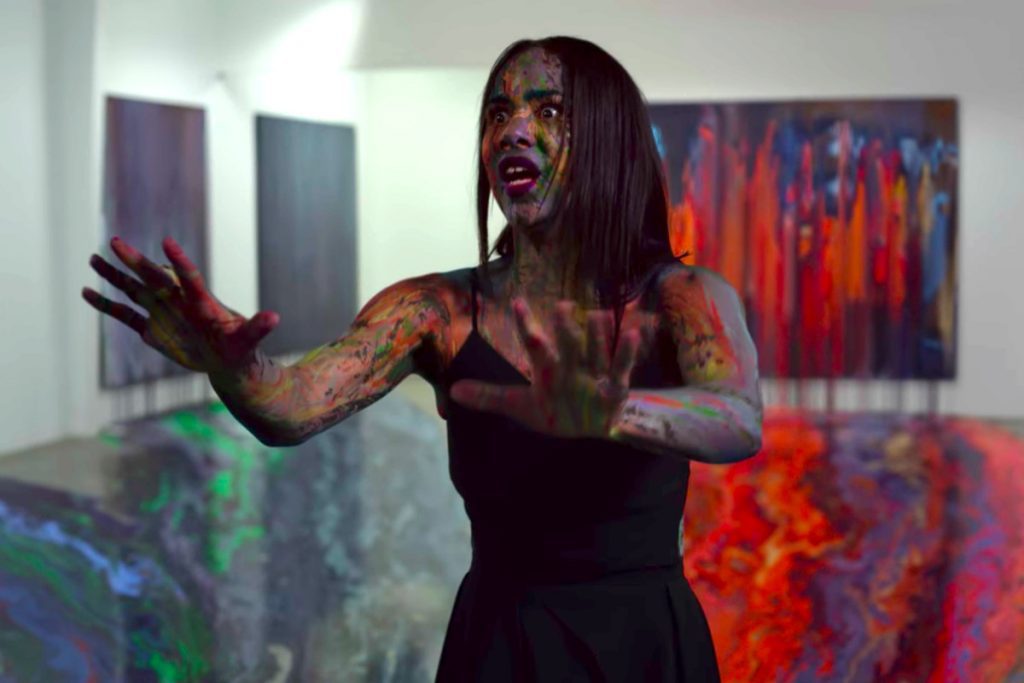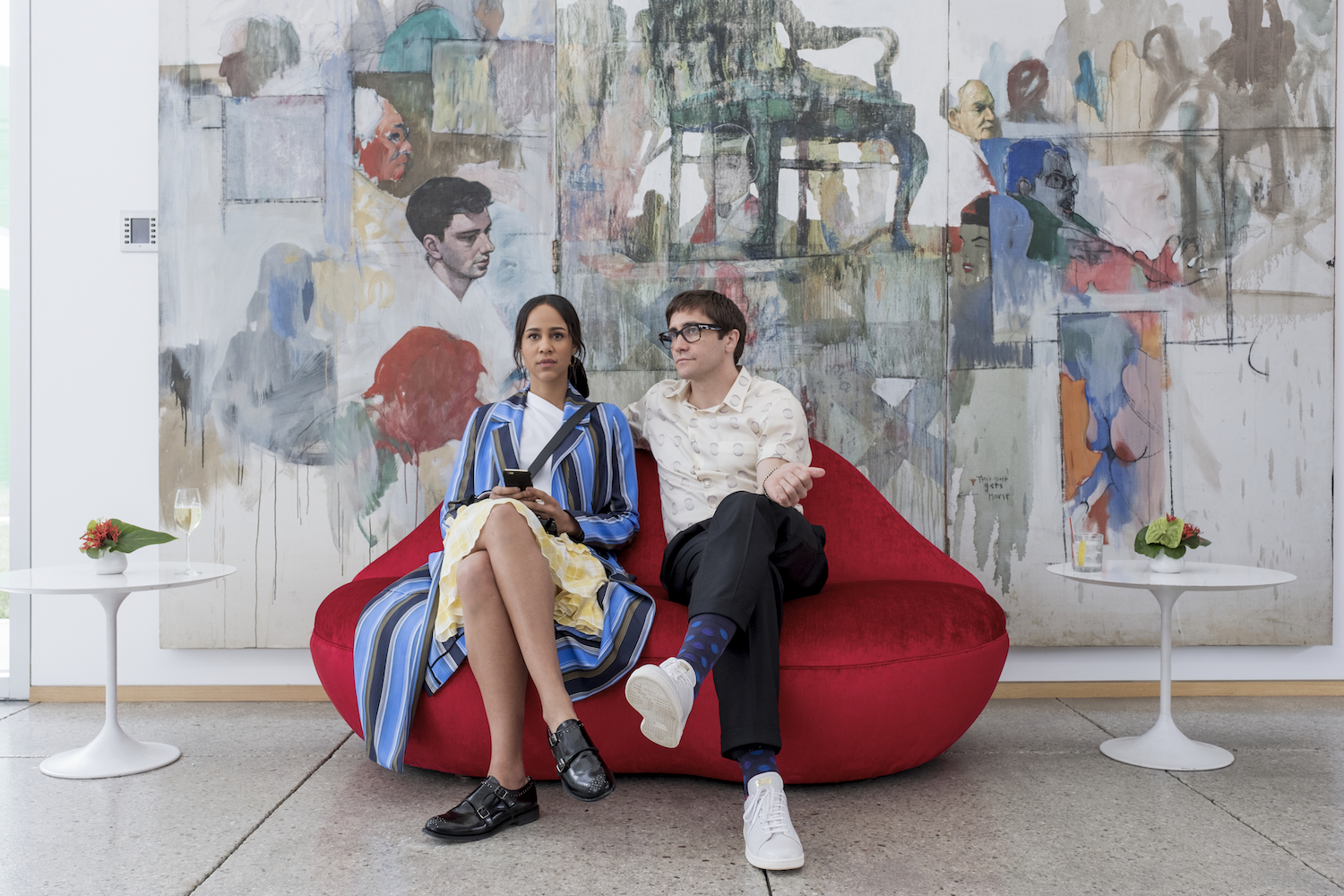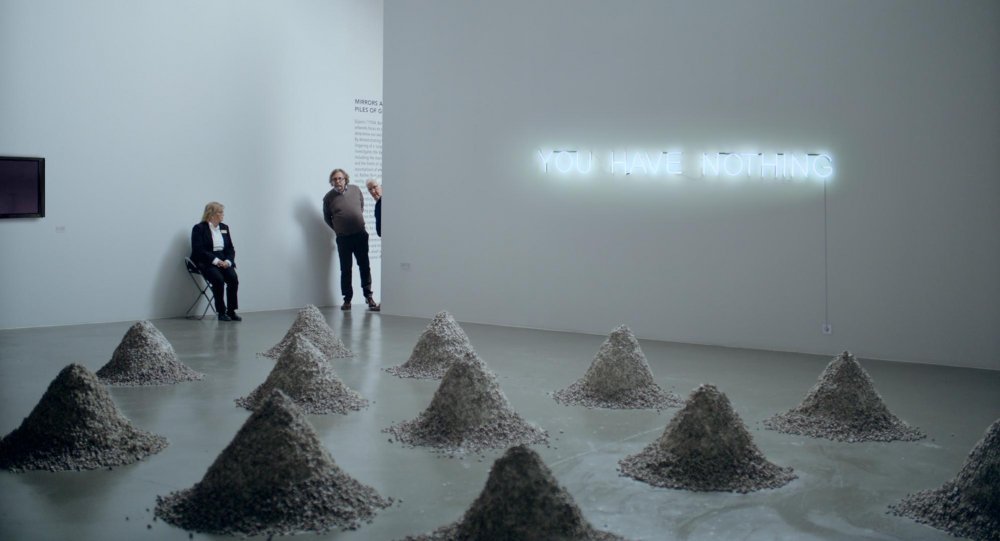
As Dan Gilroy’s Netflix film Velvet Buzzsaw opens, art critic Morf Vandewalt (Jake Gyllenhaal) glides through the VIP security lane into Art Basel Miami while others queue. He kisses art dealers on both cheeks without making contact, wears a pocket square and can make or break careers with an online review. One artist will crash his car drunk in response to a bad one. But, for now, he is shown a chrome sphere with holes in. “It’s called Sphere,” he is told. “It’s about choice, desire, sex.”
“It’s groundbreaking,” says Vandewalt instantly. “For this incredible moment I felt like I had tapped into this primal consciousness.” Later he will write the phrase “inspired disquisition” in one of his articles, and will apply the adjectives “visionary” and “mesmeric” to what we can see for ourselves is an ill-considered work. He writes his dross in LA by the pool he can somehow afford, in which a ripped boyfriend swims naked. He can also afford to hire an assistant to manage his “archive”.
Before you’ve even got to the supernatural crux of this horror movie—work discovered in the apartment of a dead outsider artist is cursed, and will kill any corrupt art world type who tries to profit from it—you’re already frightened by its preposterousness. Velvet Buzzsaw takes its cues from the real art world. Gyllenhaal said in an interview that he modelled Vandewalt on New York Magazine’s Jerry Saltz. The story of mysterious dead artist Vetril Dease, with his mental illness, seclusion and career as a janitor, echoes the life of Chicagoan Henry Darger.

But the version of the art world in which these elements exist—a sort of pre-death-of-print, Brian Sewell-tinted fantasia where critics make good money from a couple of exhibition reviews a week, live in the best postcodes and own valuable collections—doesn’t add up. It has jarred with viewers, from my flatmate who knows nothing about the art world to Jerry Saltz himself, who told the Huffington Post’s Priscilla Frank that it was “funny that a movie would have an art critic who supposedly has any power, sway or even say over prices and who’s who. And that apparently this critic seems to make money.”
But then, something near an accurate portrayal of the art world is rarely the goal of TV and films set in the art world. Much more fun are the self-sustaining clichés that pop culture has formed and peddled over the years. It’s not just Velvet Buzzsaw. Most attempts to show it are doomed, cursed or make a pact with the devil. Even the very enjoyable ones. The first season of Lena Dunham’s Girls (2012) typifies this with a young, successful artist named Booth Jonathan, played by Jorma Taccone. He desecrates doll houses and builds towers of televisions showing found footage, like a parody of Sarah Sze
(who Dunham has, coincidentally, known all her life through her parents Laurie Simmons and Carroll Dunham, who are fixtures of the New York art world).
“Before you’ve even got to the supernatural crux of this horror movie, you’re already frightened by its preposterousness”
The Tribeca studio where Dunham grew up served as the set for her 2010 film Tiny Furniture, which featured her mother as an artist parent, and portrayed herself making a video art piece of brushing her teeth in a college fountain. If anyone is in a position to present the art world, there are few young filmmakers with such a specific skill set, knowledge and platform. But while the art world Dunham presents in Girls looks correct, it has also been constructed specifically to foreground the received ideas pop culture has already given audiences about the environment. Why? Because it is familiar, and because it affords more comic potential.
We meet Booth Jonathan when gallery assistant Marnie (Allison Williams) is on the upper level of a white cube-style gallery. It’s an opening, and her boss is a classic art world gargoyle that we know so well from other shows and films: eyeing up one of her interns; gossiping about other famous people’s affairs. A season later we see Booth talking in front of a wall-sized projection that shows his own face at the moment he saw a Marina Abramovic work: “And then suddenly, I’m sobbing. Which I never do.”
It feels as if Dunham and her production team have taken inspiration from Charlie Brooker and Chris Morris’s character 15 Peter 20, the artist in their 2005 show Nathan Barley, who also has a silly name and speaks earnestly. His main project involved capturing the vulnerability of himself and celebrities by photographing them pissing in letter boxes and toasters. 15 Peter calls them “the most revealing portrait photos ever taken” and believes “pissing is like crying through your genitals”. The absurd contemporary artist is an easier target than the snooty, wealthy critic because they remain closer to reality while still making great viewing entertainment.
In Sex and the City, central character Charlotte York Goldenblatt (Kristin Davis) is an art dealer, offering much scope for the portrayal of the New York art world. More stereotypes can be found in its six seasons than anywhere else on mainstream television. The pilot begins with a fable about an English journalist fresh off the plane, who meets an investment banker “in typical New York fashion, at a gallery opening”.
The next episode features an artist who “maintained a fabulous lifestyle despite never having sold a single painting”, and who secretly videos himself having sex with models to watch them back on a stack of TVs. There is a woke “bro” photographer who tries to seduce women under the guise of encouraging them to cross-dress or interrogate gender. There’s the classic art boor: a star who asks the price of a gallery’s fire extinguisher. “You can say you got it from the gallery and people will probably think it’s a Jeff Koons,” Charlotte tells him.
“Most attempts to show the art world onscreen are doomed, cursed or make a pact with the devil”

Meanwhile, 2018 film The Square opens with a journalist called Anne (Elisabeth Moss) asking Christian (Claes Bang), a curator of a major contemporary museum, to explain a knotty text he has written, which he has to look at again before attempting to untangle his own words. When Dominic West, playing an artist, is speaking on a panel about similar themes, he is interrupted repeatedly by an audience member with Tourettes who can’t help but shout “garbage”. The Square is a film made to poke fun at those “in the know”, but falls short in the inevitable flattery of those knowledgeable enough of this strange and seemingly surreal industry, built on mythology and the power of belief, to pull off any true bite.
In the 1999 episode of the Simpsons, titled Mom and Pop Art, Homer’s attempt at making a barbecue in his garden unwittingly becomes a contemporary sculpture after it collides with the car of gallerist Astrid Weller. “This isn’t art,” says Homer. “It’s just a barbecue that pushed me over the edge.” But in Astrid’s eyes it is “outsider art”. It is one of the most successful comic depictions of the art world despite the fact that its target isn’t necessary the art world but, rather, the shock of the new itself. People cease to find Homer’s art interesting when subsequent works are too similar to his first.
And yet, when we see the art world depicted on screen, we rarely ask for the same novel experience that we ask of our visual art. We are happy seeing the same artifice made around a version of the art world, again and again. And this might be for its familiarity, but it might also be because the construction of onscreen art world clichés is an ongoing entity with its own theory and rules. Perhaps an artwork could stand to be made of all these depictions of the art world and its artists, shown simultaneously on a stack of TVs.





